
A | B | C | D | E | F | G | H | CH | I | J | K | L | M | N | O | P | Q | R | S | T | U | V | W | X | Y | Z | 0 | 1 | 2 | 3 | 4 | 5 | 6 | 7 | 8 | 9
| Part of a series on |
| Sociology |
|---|
 |
Globalization, or globalisation (Commonwealth English; see spelling differences), is the process of interaction and integration among people, companies, and governments worldwide. The term globalization first appeared in the early 20th century (supplanting an earlier French term mondialisation), developed its current meaning sometime in the second half of the 20th century, and came into popular use in the 1990s to describe the unprecedented international connectivity of the post-Cold War world.[1] Its origins can be traced back to 18th and 19th centuries due to advances in transportation and communications technology. This increase in global interactions has caused a growth in international trade and the exchange of ideas, beliefs, and culture. Globalization is primarily an economic process of interaction and integration that is associated with social and cultural aspects. However, disputes and international diplomacy are also large parts of the history of globalization, and of modern globalization.
Economically, globalization involves goods, services, data, technology, and the economic resources of capital.[2] The expansion of global markets liberalizes the economic activities of the exchange of goods and funds. Removal of cross-border trade barriers has made the formation of global markets more feasible.[3] Advances in transportation, like the steam locomotive, steamship, jet engine, and container ships, and developments in telecommunication infrastructure such as the telegraph, the Internet, mobile phones, and smartphones, have been major factors in globalization and have generated further interdependence of economic and cultural activities around the globe.[4][5][6]
Though many scholars place the origins of globalization in modern times, others trace its history to long before the European Age of Discovery and voyages to the New World, and some even to the third millennium BCE.[7] Large-scale globalization began in the 1820s, and in the late 19th century and early 20th century drove a rapid expansion in the connectivity of the world's economies and cultures.[8] The term global city was subsequently popularized by sociologist Saskia Sassen in her work The Global City: New York, London, Tokyo (1991).[9]
In 2000, the International Monetary Fund (IMF) identified four basic aspects of globalization: trade and transactions, capital and investment movements, migration and movement of people, and the dissemination of knowledge.[10] Globalizing processes affect and are affected by business and work organization, economics, sociocultural resources, and the natural environment. Academic literature commonly divides globalization into three major areas: economic globalization, cultural globalization, and political globalization.[11]
Etymology and usage
The word globalization was used in the English language as early as the 1930s, but only in the context of education, and the term failed to gain traction. Over the next few decades, the term was occasionally used by other scholars and media, but it was not clearly defined.[1] One of the first usages of the term in the meaning resembling the later, common usage was by French economist François Perroux in his essays from the early 1960s (in his French works he used the term "mondialisation" (literarly worldization in French), also translated as mundialization).[1] Theodore Levitt is often credited with popularizing the term and bringing it into the mainstream business audience in the later in the middle of 1980s.[1]
Though often treated as synonyms, in French, globalization is seen as a stage following mondialisation, a stage that implies the dissolution of national identities and the abolishment of borders inside the world network of economic exchanges.[12]
Since its inception, the concept of globalization has inspired competing definitions and interpretations. Its antecedents date back to the great movements of trade and empire across Asia and the Indian Ocean from the 15th century onward.[13][14]
In 1848, Karl Marx noticed the increasing level of national inter-dependence brought on by capitalism, and predicted the universal character of the modern world society. He states:
The bourgeoisie has through its exploitation of the world market given a cosmopolitan character to production and consumption in every country. To the great chagrin of Reactionists, it has drawn from under the feet of industry the national ground on which it stood. All old-established national industries have been destroyed or are daily being destroyed. . . . In place of the old local and national seclusion and self-sufficiency, we have intercourse in every direction, universal inter-dependence of nations.[15]
Sociologists Martin Albrow and Elizabeth King define globalization as "all those processes by which the people of the world are incorporated into a single world society."[2] In The Consequences of Modernity, Anthony Giddens writes: "Globalization can thus be defined as the intensification of worldwide social relations which link distant localities in such a way that local happenings are shaped by events occurring many miles away and vice versa."[16] In 1992, Roland Robertson, professor of sociology at the University of Aberdeen and an early writer in the field, described globalization as "the compression of the world and the intensification of the consciousness of the world as a whole."[17]
In Global Transformations, David Held and his co-writers state:
Although in its simplistic sense globalization refers to the widening, deepening and speeding up of global interconnection, such a definition begs further elaboration. ... Globalization can be on a continuum with the local, national and regional. At one end of the continuum lie social and economic relations and networks which are organized on a local and/or national basis; at the other end lie social and economic relations and networks which crystallize on the wider scale of regional and global interactions. Globalization can refer to those spatial-temporal processes of change which underpin a transformation in the organization of human affairs by linking together and expanding human activity across regions and continents. Without reference to such expansive spatial connections, there can be no clear or coherent formulation of this term. ... A satisfactory definition of globalization must capture each of these elements: extensity (stretching), intensity, velocity and impact.[18]
Held and his co-writers' definition of globalization in that same book as "transformation in the spatial organization of social relations and transactions—assessed in terms of their extensity, intensity, velocity and impact—generating transcontinental or inter-regional flows" was called "probably the most widely-cited definition" in the 2014 DHL Global Connectiveness Index.[19]
Swedish journalist Thomas Larsson, in his book The Race to the Top: The Real Story of Globalization, states that globalization:
...is the process of world shrinkage, of distances getting shorter, things moving closer. It pertains to the increasing ease with which somebody on one side of the world can interact, to mutual benefit, with somebody on the other side of the world.[20]
Paul James defines globalization with a more direct and historically contextualized emphasis:
Globalization is the extension of social relations across world-space, defining that world-space in terms of the historically variable ways that it has been practiced and socially understood through changing world-time.[21]
Manfred Steger, professor of global studies and research leader in the Global Cities Institute at RMIT University, identifies four main empirical dimensions of globalization: economic, political, cultural, and ecological. A fifth dimension—the ideological—cutting across the other four. The ideological dimension, according to Steger, is filled with a range of norms, claims, beliefs, and narratives about the phenomenon itself.[22]
James and Steger stated that the concept of globalization "emerged from the intersection of four interrelated sets of 'communities of practice' (Wenger, 1998): academics, journalists, publishers/editors, and librarians."[1]: 424 They note the term was used "in education to describe the global life of the mind"; in international relations to describe the extension of the European Common Market, and in journalism to describe how the "American Negro and his problem are taking on a global significance".[1] They have also argued that four forms of globalization can be distinguished that complement and cut across the solely empirical dimensions.[21][23] According to James, the oldest dominant form of globalization is embodied globalization, the movement of people. A second form is agency-extended globalization, the circulation of agents of different institutions, organizations, and polities, including imperial agents. Object-extended globalization, a third form, is the movement of commodities and other objects of exchange. He calls the transmission of ideas, images, knowledge, and information across world-space disembodied globalization, maintaining that it is currently the dominant form of globalization. James holds that this series of distinctions allows for an understanding of how, today, the most embodied forms of globalization such as the movement of refugees and migrants are increasingly restricted, while the most disembodied forms such as the circulation of financial instruments and codes are the most deregulated.[24]
The journalist Thomas L. Friedman popularized the term "flat world", arguing that globalized trade, outsourcing, supply-chaining, and political forces had permanently changed the world, for better and worse. He asserted that the pace of globalization was quickening and that its impact on business organization and practice would continue to grow.[25]
Economist Takis Fotopoulos defined "economic globalization" as the opening and deregulation of commodity, capital, and labor markets that led toward present neoliberal globalization. He used "political globalization" to refer to the emergence of a transnational élite and a phasing out of the nation-state. Meanwhile, he used "cultural globalization" to reference the worldwide homogenization of culture. Other of his usages included "ideological globalization", "technological globalization", and "social globalization".[26]
Lechner and Boli (2012) define globalization as more people across large distances becoming connected in more and different ways.[27]
"Globophobia" is used to refer to the fear of globalization, though it can also mean the fear of balloons.[28][29][30]
History
There are both distal and proximate causes which can be traced in the historical factors affecting globalization. Large-scale globalization began in the 19th century.[31]
Archaic
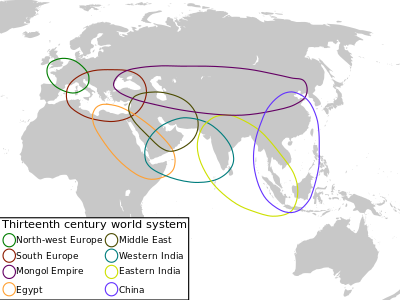
Archaic globalization conventionally refers to a phase in the history of globalization including globalizing events and developments from the time of the earliest civilizations until roughly the 1600s. This term is used to describe the relationships between communities and states and how they were created by the geographical spread of ideas and social norms at both local and regional levels.[32]
In this schema, three main prerequisites are posited for globalization to occur. The first is the idea of Eastern Origins, which shows how Western states have adapted and implemented learned principles from the East.[32] Without the spread of traditional ideas from the East, Western globalization would not have emerged the way it did. The interactions of states were not on a global scale and most often were confined to Asia, North Africa, the Middle East, and certain parts of Europe.[32] With early globalization, it was difficult for states to interact with others that were not close. Eventually, technological advances allowed states to learn of others' existence and thus another phase of globalization can occur. The third has to do with inter-dependency, stability, and regularity. If a state is not dependent on another, then there is no way for either state to be mutually affected by the other. This is one of the driving forces behind global connections and trade; without either, globalization would not have emerged the way it did and states would still be dependent on their own production and resources to work. This is one of the arguments surrounding the idea of early globalization. It is argued that archaic globalization did not function in a similar manner to modern globalization because states were not as interdependent on others as they are today.[32]
Also posited is a "multi-polar" nature to archaic globalization, which involved the active participation of non-Europeans. Because it predated the Great Divergence in the nineteenth century, where Western Europe pulled ahead of the rest of the world in terms of industrial production and economic output, archaic globalization was a phenomenon that was driven not only by Europe but also by other economically developed Old World centers such as Gujarat, Bengal, coastal China, and Japan.[33]
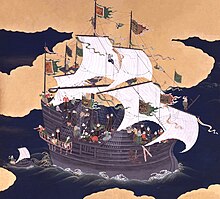
The German historical economist and sociologist Andre Gunder Frank argues that a form of globalization began with the rise of trade links between Sumer and the Indus Valley civilization in the third millennium BCE. This archaic globalization existed during the Hellenistic Age, when commercialized urban centers enveloped the axis of Greek culture that reached from India to Spain, including Alexandria and the other Alexandrine cities. Early on, the geographic position of Greece and the necessity of importing wheat forced the Greeks to engage in maritime trade. Trade in ancient Greece was largely unrestricted: the state controlled only the supply of grain.[7]


Trade on the Silk Road was a significant factor in the development of civilizations from China, the Indian subcontinent, Persia, Europe, and Arabia, opening long-distance political and economic interactions between them.[34] Though silk was certainly the major trade item from China, common goods such as salt and sugar were traded as well; and religions, syncretic philosophies, and various technologies, as well as diseases, also traveled along the Silk Routes. In addition to economic trade, the Silk Road served as a means of carrying out cultural trade among the civilizations along its network.[35] The movement of people, such as refugees, artists, craftsmen, missionaries, robbers, and envoys, resulted in the exchange of religions, art, languages, and new technologies.[36]
Early modern
"Early modern" or "proto-globalization" covers a period of the history of globalization roughly spanning the years between 1600 and 1800. The concept of "proto-globalization" was first introduced by historians A. G. Hopkins and Christopher Bayly. The term describes the phase of increasing trade links and cultural exchange that characterized the period immediately preceding the advent of high "modern globalization" in the late 19th century.[37] This phase of globalization was characterized by the rise of maritime European empires, in the 15th and 17th centuries, first the Portuguese Empire (1415) followed by the Spanish Empire (1492), and later the Dutch and British Empires. In the 17th century, world trade developed further when chartered companies like the British East India Company (founded in 1600) and the Dutch East India Company (founded in 1602, often described as the first multinational corporation in which stock was offered) were established.[38]
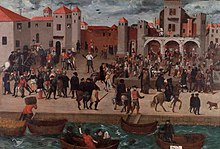
An alternative view from historians Dennis Flynn and Arturo Giraldez, postulated that: globalization began with the first circumnavigation of the globe under the Magellan-Elcano expedition which preluded the rise of global silver trade.[39][40]
Early modern globalization is distinguished from modern globalization on the basis of expansionism, the method of managing global trade, and the level of information exchange. The period is marked by the shift of hegemony to Western Europe, the rise of larger-scale conflicts between powerful nations such as the Thirty Years' War, and demand for commodities, most particularly slaves. The triangular trade made it possible for Europe to take advantage of resources within the Western Hemisphere. The transfer of animal stocks, plant crops, and epidemic diseases associated with Alfred W. Crosby's concept of the Columbian exchange also played a central role in this process. European, Middle Eastern, Indian, Southeast Asian, and Chinese merchants were all involved in early modern trade and communications, particularly in the Indian Ocean region.


Modern
According to economic historians Kevin H. O'Rourke, Leandro Prados de la Escosura, and Guillaume Daudin, several factors promoted globalization in the period 1815–1870:[41]
- The conclusion of the Napoleonic Wars brought in an era of relative peace in Europe.
- Innovations in transportation technology reduced trade costs substantially.
- New industrial military technologies increased the power of European states and the United States, and allowed these powers to forcibly open up markets across the world and extend their empires.
- A gradual move towards greater liberalization in European countries.
During the 19th century, globalization approached its form as a direct result of the Industrial Revolution. Industrialization allowed standardized production of household items using economies of scale while rapid population growth created sustained demand for commodities. In the 19th century, steamships reduced the cost of international transportation significantly and railroads made inland transportation cheaper. The transportation revolution occurred some time between 1820 and 1850.[31] More nations embraced international trade.[31] Globalization in this period was decisively shaped by nineteenth-century imperialism such as in Africa and Asia. The invention of shipping containers in 1956 helped advance the globalization of commerce.[42][43]
After World War II, work by politicians led to the agreements of the Bretton Woods Conference, in which major governments laid down the framework for international monetary policy, commerce, and finance, and the founding of several international institutions intended to facilitate economic growth by lowering trade barriers. Initially, the General Agreement on Tariffs and Trade (GATT) led to a series of agreements to remove trade restrictions. GATT's successor was the World Trade Organization (WTO), which provided a framework for negotiating and formalizing trade agreements and a dispute resolution process. Exports nearly doubled from 8.5% of total gross world product in 1970 to 16.2% in 2001.[44] The approach of using global agreements to advance trade stumbled with the failure of the Doha Development Round of trade negotiation. Many countries then shifted to bilateral or smaller multilateral agreements, such as the 2011 United States–Korea Free Trade Agreement.
Since the 1970s, aviation has become increasingly affordable to middle classes in developed countries. Open skies policies and low-cost carriers have helped to bring competition to the market. In the 1990s, the growth of low-cost communication networks cut the cost of communicating between countries. More work can be performed using a computer without regard to location. This included accounting, software development, and engineering design.
Student exchange programs became popular after World War II, and are intended to increase the participants' understanding and tolerance of other cultures, as well as improving their language skills and broadening their social horizons. Between 1963 and 2006 the number of students studying in a foreign country increased 9 times.[45]

Since the 1980s, modern globalization has spread rapidly through the expansion of capitalism and neoliberal ideologies.[46] The implementation of neoliberal policies has allowed for the privatization of public industry, deregulation of laws or policies that interfered with the free flow of the market, as well as cut-backs to governmental social services.[47] These neoliberal policies were introduced to many developing countries in the form of structural adjustment programs (SAPs) that were implemented by the World Bank and the International Monetary Fund (IMF).[46] These programs required that the country receiving monetary aid would open its markets to capitalism, privatize public industry, allow free trade, cut social services like healthcare and education and allow the free movement of giant multinational corporations.[48] These programs allowed the World Bank and the IMF to become global financial market regulators that would promote neoliberalism and the creation of free markets for multinational corporations on a global scale.[49]

In the late 19th and early 20th century, the connectedness of the world's economies and cultures grew very quickly. This slowed down from the 1910s onward due to the World Wars and the Cold War,[50] but picked up again in the 1980s and 1990s.[51] The revolutions of 1989 and subsequent liberalization in many parts of the world resulted in a significant expansion of global interconnectedness. The migration and movement of people can also be highlighted as a prominent feature of the globalization process. In the period between 1965 and 1990, the proportion of the labor force migrating approximately doubled. Most migration occurred between the developing countries and least developed countries (LDCs).[52] As economic integration intensified workers moved to areas with higher wages and most of the developing world oriented toward the international market economy. The collapse of the Soviet Union not only ended the Cold War's division of the world – it also left the United States its sole policeman and an unfettered advocate of free market.[according to whom?] It also resulted in the growing prominence of attention focused on the movement of diseases, the proliferation of popular culture and consumer values, the growing prominence of international institutions like the UN, and concerted international action on such issues as the environment and human rights.[53] Other developments as dramatic were the Internet's becoming influential in connecting people across the world; As of June 2012[update], more than 2.4 billion people—over a third of the world's human population—have used the services of the Internet.[54][55] Growth of globalization has never been smooth. One influential event was the late 2000s recession, which was associated with lower growth (in areas such as cross-border phone calls and Skype usage) or even temporarily negative growth (in areas such as trade) of global interconnectedness.[56][57]
The China–United States trade war, starting in 2018, negatively affected trade between the two largest national economies. The economic impact of the COVID-19 pandemic included a massive decline in tourism and international business travel as many countries temporarily closed borders. The 2021–2022 global supply chain crisis resulted from temporary shutdowns of manufacturing and transportation facilities, and labor shortages. Supply problems incentivized some switches to domestic production.[58] The economic impact of the 2022 Russian invasion of Ukraine included a blockade of Ukrainian ports and international sanctions on Russia, resulting in some de-coupling of the Russian economy with global trade, especially with the European Union and other Western countries.
Modern consensus for the last 15 years regards globalization as having run its course and gone into decline.[59] A common argument for this is that trade has dropped since its peak in 2008, and never recovered since the global financial crisis. New opposing views from some economists have argued such trends are a result of price drops and in actuality, trade volume is increasing, especially with agricultural products, natural resources and refined petroleum.[60][61]
Economic globalization
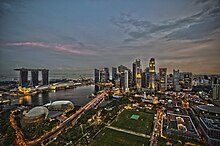
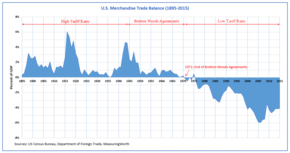

Economic globalization is the increasing economic interdependence of national economies across the world through a rapid increase in cross-border movement of goods, services, technology, and capital.[63] Whereas the globalization of business is centered around the diminution of international trade regulations as well as tariffs, taxes, and other impediments that suppresses global trade, economic globalization is the process of increasing economic integration between countries, leading to the emergence of a global marketplace or a single world market.[64] Depending on the paradigm, economic globalization can be viewed as either a positive or a negative phenomenon. Economic globalization comprises: globalization of production; which refers to the obtainment of goods and services from a particular source from locations around the globe to benefit from difference in cost and quality. Likewise, it also comprises globalization of markets; which is defined as the union of different and separate markets into a massive global marketplace. Economic globalization also includes[65] competition, technology, and corporations and industries.[63]
Current globalization trends can be largely accounted for by developed economies integrating with less developed economies by means of foreign direct investment, the reduction of trade barriers as well as other economic reforms, and, in many cases, immigration.[66]
International standards have made trade in goods and services more efficient. An example of such standard is the intermodal container. Containerization dramatically reduced the costs of transportation, supported the post-war boom in international trade, and was a major element in globalization.[42] International standards are set by the International Organization for Standardization, which is composed of representatives from various national standards organizations.
A multinational corporation, or worldwide enterprise,[67] is an organization that owns or controls the production of goods or services in one or more countries other than their home country.[68] It can also be referred to as an international corporation, a transnational corporation, or a stateless corporation.[69]
A free-trade area is the region encompassing a trade bloc whose member countries have signed a free-trade agreement (FTA). Such agreements involve cooperation between at least two countries to reduce trade barriers – import quotas and tariffs – and to increase trade of goods and services with each other.[70]
If people are also free to move between the countries, in addition to a free-trade agreement, it would also be considered an open border. Arguably, the most significant free-trade area in the world is the European Union, a politico-economic union of 27 member states that are primarily located in Europe. The EU has developed European Single Market through a standardized system of laws that apply in all member states. EU policies aim to ensure the free movement of people, goods, services, and capital within the internal market,[71]
Trade facilitation looks at how procedures and controls governing the movement of goods across national borders can be improved to reduce associated cost burdens and maximize efficiency while safeguarding legitimate regulatory objectives.
Global trade in services is also significant. For example, in India, business process outsourcing has been described as the "primary engine of the country's development over the next few decades, contributing broadly to GDP growth, employment growth, and poverty alleviation".[72][73]
William I. Robinson's theoretical approach to globalization is a critique of Wallerstein's World Systems Theory. He believes that the global capital experienced today is due to a new and distinct form of globalization which began in the 1980s. Robinson argues not only are economic activities expanded across national boundaries but also there is a transnational fragmentation of these activities.[74] One important aspect of Robinson's globalization theory is that production of goods are increasingly global. This means that one pair of shoes can be produced by six countries, each contributing to a part of the production process.
Cultural globalization

Cultural globalization refers to the transmission of ideas, meanings, and values around the world in such a way as to extend and intensify social relations.[75] This process is marked by the common consumption of cultures that have been diffused by the Internet, popular culture media, and international travel. This has added to processes of commodity exchange and colonization which have a longer history of carrying cultural meaning around the globe. The circulation of cultures enables individuals to partake in extended social relations that cross national and regional borders. The creation and expansion of such social relations is not merely observed on a material level. Cultural globalization involves the formation of shared norms and knowledge with which people associate their individual and collective cultural identities. It brings increasing interconnectedness among different populations and cultures.[76]
Cross-cultural communication is a field of study that looks at how people from differing cultural backgrounds communicate, in similar and different ways among themselves, and how they endeavor to communicate across cultures. Intercultural communication is a related field of study.
Cultural diffusion is the spread of cultural items—such as ideas, styles, religions, technologies, languages etc. Cultural globalization has increased cross-cultural contacts, but may be accompanied by a decrease in the uniqueness of once-isolated communities. For example, sushi is available in Germany as well as Japan, but Euro-Disney outdraws the city of Paris, potentially reducing demand for "authentic" French pastry.[77][78][79] Globalization's contribution to the alienation of individuals from their traditions may be modest compared to the impact of modernity itself, as alleged by existentialists such as Jean-Paul Sartre and Albert Camus. Globalization has expanded recreational opportunities by spreading pop culture, particularly via the Internet and satellite television. The cultural diffusion can create a homogenizing force, where globalization is seen as synonymous with homogenizing force via connectedness of markets, cultures, politics and the desire for modernizations through imperial countries sphere of influence.[80]
Religions were among the earliest cultural elements to globalize, being spread by force, migration, evangelists, imperialists, and traders. Christianity, Islam, Buddhism, and more recently sects such as Mormonism are among those religions which have taken root and influenced endemic cultures in places far from their origins.[81]
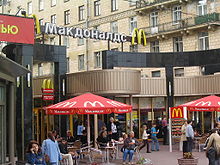
Globalization has strongly influenced sports.[82] For example, the modern Olympic Games has athletes from more than 200 nations participating in a variety of competitions.[83] The FIFA World Cup is the most widely viewed and followed sporting event in the world, exceeding even the Olympic Games; a ninth of the entire population of the planet watched the 2006 FIFA World Cup Final.[84][85][86]
The term globalization implies transformation. Cultural practices including traditional music can be lost or turned into a fusion of traditions. Globalization can trigger a state of emergency for the preservation of musical heritage. Archivists may attempt to collect, record, or transcribe repertoires before melodies are assimilated or modified, while local musicians may struggle for authenticity and to preserve local musical traditions. Globalization can lead performers to discard traditional instruments. Fusion genres can become interesting fields of analysis.[87]
Music has an important role in economic and cultural development during globalization. Music genres such as jazz and reggae began locally and later became international phenomena. Globalization gave support to the world music phenomenon by allowing music from developing countries to reach broader audiences.[88] Though the term "World Music" was originally intended for ethnic-specific music, globalization is now expanding its scope such that the term often includes hybrid subgenres such as "world fusion", "global fusion", "ethnic fusion",[89] and worldbeat.[90][91]

Bourdieu claimed that the perception of consumption can be seen as self-identification and the formation of identity. Musically, this translates into each individual having their own musical identity based on likes and tastes. These likes and tastes are greatly influenced by culture, as this is the most basic cause for a person's wants and behavior. The concept of one's own culture is now in a period of change due to globalization. Also, globalization has increased the interdependency of political, personal, cultural, and economic factors.[93]
A 2005 UNESCO report[94] showed that cultural exchange is becoming more frequent from Eastern Asia, but that Western countries are still the main exporters of cultural goods. In 2002, China was the third largest exporter of cultural goods, after the UK and US. Between 1994 and 2002, both North America's and the European Union's shares of cultural exports declined while Asia's cultural exports grew to surpass North America. Related factors are the fact that Asia's population and area are several times that of North America. Americanization is related to a period of high political American clout and of significant growth of America's shops, markets and objects being brought into other countries.
Some critics of globalization argue that it harms the diversity of cultures. As a dominating country's culture is introduced into a receiving country through globalization, it can become a threat to the diversity of local culture. Some argue that globalization may ultimately lead to Westernization or Americanization of culture, where the dominating cultural concepts of economically and politically powerful Western countries spread and cause harm to local cultures.[95]
Globalization is a diverse phenomenon that relates to a multilateral political world and to the increase of cultural objects and markets between countries. The Indian experience particularly reveals the plurality of the impact of cultural globalization.[96]
Transculturalism is defined as "seeing oneself in the other".[97] Transcultural[98] is in turn described as "extending through all human cultures"[98] or "involving, encompassing, or combining elements of more than one culture".[99] Children brought up in transcultural backgrounds are sometimes called third-culture kids.
Political globalization

Political globalization refers to the growth of the worldwide political system, both in size and complexity. That system includes national governments, their governmental and intergovernmental organizations as well as government-independent elements of global civil society such as international non-governmental organizations and social movement organizations. One of the key aspects of the political globalization is the declining importance of the nation-state and the rise of other actors on the political scene. William R. Thompson has defined it as "the expansion of a global political system, and its institutions, in which inter-regional transactions (including, but certainly not limited to trade) are managed".[100] Political globalization is one of the three main dimensions of globalization commonly found in academic literature, with the two other being economic globalization and cultural globalization.[11]
Intergovernmentalism is a term in political science with two meanings. The first refers to a theory of regional integration originally proposed by Stanley Hoffmann; the second treats states and the national government as the primary factors for integration. Multi-level governance is an approach in political science and public administration theory that originated from studies on European integration. Multi-level governance gives expression to the idea that there are many interacting authority structures at work in the emergent global political economy. It illuminates the intimate entanglement between the domestic and international levels of authority.
Some people are citizens of multiple nation-states. Multiple citizenship, also called dual citizenship or multiple nationality or dual nationality, is a person's citizenship status, in which a person is concurrently regarded as a citizen of more than one state under the laws of those states.

Increasingly, non-governmental organizations influence public policy across national boundaries, including humanitarian aid and developmental efforts.[102] Philanthropic organizations with global missions are also coming to the forefront of humanitarian efforts; charities such as the Bill and Melinda Gates Foundation, Accion International, the Acumen Fund (now Acumen) and the Echoing Green have combined the business model with philanthropy, giving rise to business organizations such as the Global Philanthropy Group and new associations of philanthropists such as the Global Philanthropy Forum. The Bill and Melinda Gates Foundation projects include a current multibillion-dollar commitment to funding immunizations in some of the world's more impoverished but rapidly growing countries.[103] The Hudson Institute estimates total private philanthropic flows to developing countries at US$59 billion in 2010.[104]
As a response to globalization, some countries have embraced isolationist policies. For example, the North Korean government makes it very difficult for foreigners to enter the country and strictly monitors their activities when they do. Aid workers are subject to considerable scrutiny and excluded from places and regions the government does not wish them to enter. Citizens cannot freely leave the country.[105][106]
Globalization and gender

This section needs additional citations for verification. (April 2024) |
Globalization has been a gendered process where giant multinational corporations have outsourced jobs to low-wage, low skilled, quota free economies like the ready made garment industry in Bangladesh where poor women make up the majority of labor force. Despite a large proportion of women workers in the garment industry, women are still heavily underemployed compared to men. Most women that are employed in the garment industry come from the countryside of Bangladesh triggering migration of women in search of garment work. It is still unclear as to whether or not access to paid work for women where it did not exist before has empowered them. The answers varied depending on whether it is the employers perspective or the workers and how they view their choices. Women workers did not see the garment industry as economically sustainable for them in the long run due to long hours standing and poor working conditions. Although women workers did show significant autonomy over their personal lives including their ability to negotiate with family, more choice in marriage, and being valued as a wage earner in the family. This did not translate into workers being able to collectively organize themselves in order to negotiate a better deal for themselves at work.[107]
Another example of outsourcing in manufacturing includes the maquiladora industry in Ciudad Juarez, Mexico where poor women make up the majority of the labor force. Women in the maquiladora industry have produced high levels of turnover not staying long enough to be trained compared to men. A gendered two tiered system within the maquiladora industry has been created that focuses on training and worker loyalty. Women are seen as being untrainable, placed in un-skilled, low wage jobs, while men are seen as more trainable with less turnover rates, and placed in more high skilled technical jobs. The idea of training has become a tool used against women to blame them for their high turnover rates which also benefit the industry keeping women as temporary workers.[108]
Other dimensions
Scholars also occasionally discuss other, less common dimensions of globalization, such as environmental globalization (the internationally coordinated practices and regulations, often in the form of international treaties, regarding environmental protection)[109] or military globalization (growth in global extent and scope of security relationships).[110] Those dimensions, however, receive much less attention the three described above, as academic literature commonly subdivides globalization into three major areas: economic globalization, cultural globalization and political globalization.[11]
Movement of people
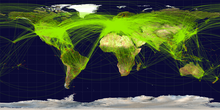
An essential aspect of globalization is movement of people, and state-boundary limits on that movement have changed across history.[111] The movement of tourists and business people opened up over the last century. As transportation technology improved, travel time and costs decreased dramatically between the 18th and early 20th century. For example, travel across the Atlantic Ocean used to take up to 5 weeks in the 18th century, but around the time of the 20th century it took a mere 8 days.[112] Today, modern aviation has made long-distance transportation quick and affordable.
Tourism is travel for pleasure. The developments in technology and transportation infrastructure, such as jumbo jets, low-cost airlines, and more accessible airports have made many types of tourism more affordable. At any given moment half a million people are in the air.[113] International tourist arrivals surpassed the milestone of 1 billion tourists globally for the first time in 2012.[114] A visa is a conditional authorization granted by a country to a foreigner, allowing them to enter and temporarily remain within, or to leave that country. Some countries – such as those in the Schengen Area – have agreements with other countries allowing each other's citizens to travel between them without visas (for example, Switzerland is part of a Schengen Agreement allowing easy travel for people from countries within the European Union). The World Tourism Organization announced that the number of tourists who require a visa before traveling was at its lowest level ever in 2015.[115]
Immigration is the international movement of people into a destination country of which they are not natives or where they do not possess citizenship in order to settle or reside there, especially as permanent residents or naturalized citizens, or to take-up employment as a migrant worker or temporarily as a foreign worker.[116][117][118] According to the International Labour Organization, as of 2014[update] there were an estimated 232 million international migrants in the world (defined as persons outside their country of origin for 12 months or more) and approximately half of them were estimated to be economically active (i.e. being employed or seeking employment).[119] International movement of labor is often seen as important to economic development. For example, freedom of movement for workers in the European Union means that people can move freely between member states to live, work, study or retire in another country.

Globalization is associated with a dramatic rise in international education. The development of global cross-cultural competence in the workforce through ad-hoc training has deserved increasing attention in recent times.[121][122] More and more students are seeking higher education in foreign countries and many international students now consider overseas study a stepping-stone to permanent residency within a country.[123] The contributions that foreign students make to host nation economies, both culturally and financially has encouraged major players to implement further initiatives to facilitate the arrival and integration of overseas students, including substantial amendments to immigration and visa policies and procedures.[45]
A transnational marriage is a marriage between two people from different countries. A variety of special issues arise in marriages between people from different countries, including those related to citizenship and culture, which add complexity and challenges to these kinds of relationships. In an age of increasing globalization, where a growing number of people have ties to networks of people and places across the globe, rather than to a current geographic location, people are increasingly marrying across national boundaries. Transnational marriage is a by-product of the movement and migration of people.
Movement of information
| Region | 2005 | 2010 | 2017 | 2023 |
|---|---|---|---|---|
| Africa | 2% | 10% | 21.8% | 37% |
| Americas | 36% | 49% | 65.9% | 87% |
| Arab States | 8% | 26% | 43.7% | 69% |
| Asia and Pacific | 9% | 23% | 43.9% | 66% |
| Commonwealth of Independent States |
10% | 34% | 67.7% | 89% |
| Europe | 46% | 67% | 79.6% | 91% |

Before electronic communications, long-distance communications relied on mail. Speed of global communications was limited by the maximum speed of courier services (especially horses and ships) until the mid-19th century. The electric telegraph was the first method of instant long-distance communication. For example, before the first transatlantic cable, communications between Europe and the Americas took weeks because ships had to carry mail across the ocean. The first transatlantic cable reduced communication time considerably, allowing a message and a response in the same day. Lasting transatlantic telegraph connections were achieved in the 1865–1866. The first wireless telegraphy transmitters were developed in 1895.
The Internet has been instrumental in connecting people across geographical boundaries. For example, Facebook is a social networking service which has more than 1.65 billion monthly active users as of 31 March 2016[update].[125]
Globalization can be spread by Global journalism which provides massive information and relies on the internet to interact, "makes it into an everyday routine to investigate how people and their actions, practices, problems, life conditions, etc. in different parts of the world are interrelated. possible to assume that global threats such as climate change precipitate the further establishment of global journalism."[126]
Globalization and disease
In the current era of globalization, the world is more interdependent than at any other time. Efficient and inexpensive transportation has left few places inaccessible, and increased global trade has brought more and more people into contact with animal diseases that have subsequently jumped species barriers (see zoonosis).[127]
Coronavirus disease 2019, abbreviated COVID-19, first appeared in Wuhan, China in November 2019. More than 180 countries have reported cases since then.[128] As of April 6, 2020[update], the U.S. has the most confirmed active cases in the world.[129] More than 3.4 million people from the worst-affected countries entered the U.S. in the first three months since the inception of the COVID-19 pandemic.[130] This has caused a detrimental impact on the global economy, particularly for SME's and Microbusinesses with unlimited liability/self-employed, leaving them vulnerable to financial difficulties, increasing the market share for oligopolistic markets as well as increasing the barriers of entry.
Measurement
One index of globalization is the KOF Index of Globalization, which measures three important dimensions of globalization: economic, social, and political.[131] Another is the A.T. Kearney / Foreign Policy Magazine Globalization Index.[132]





